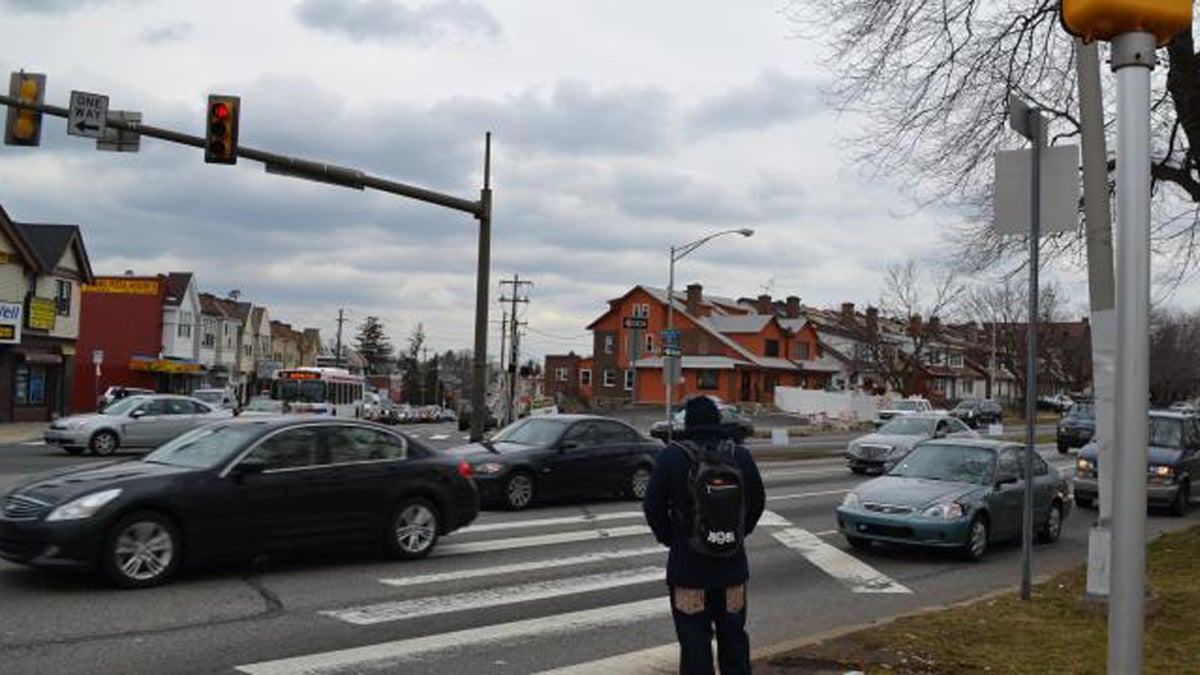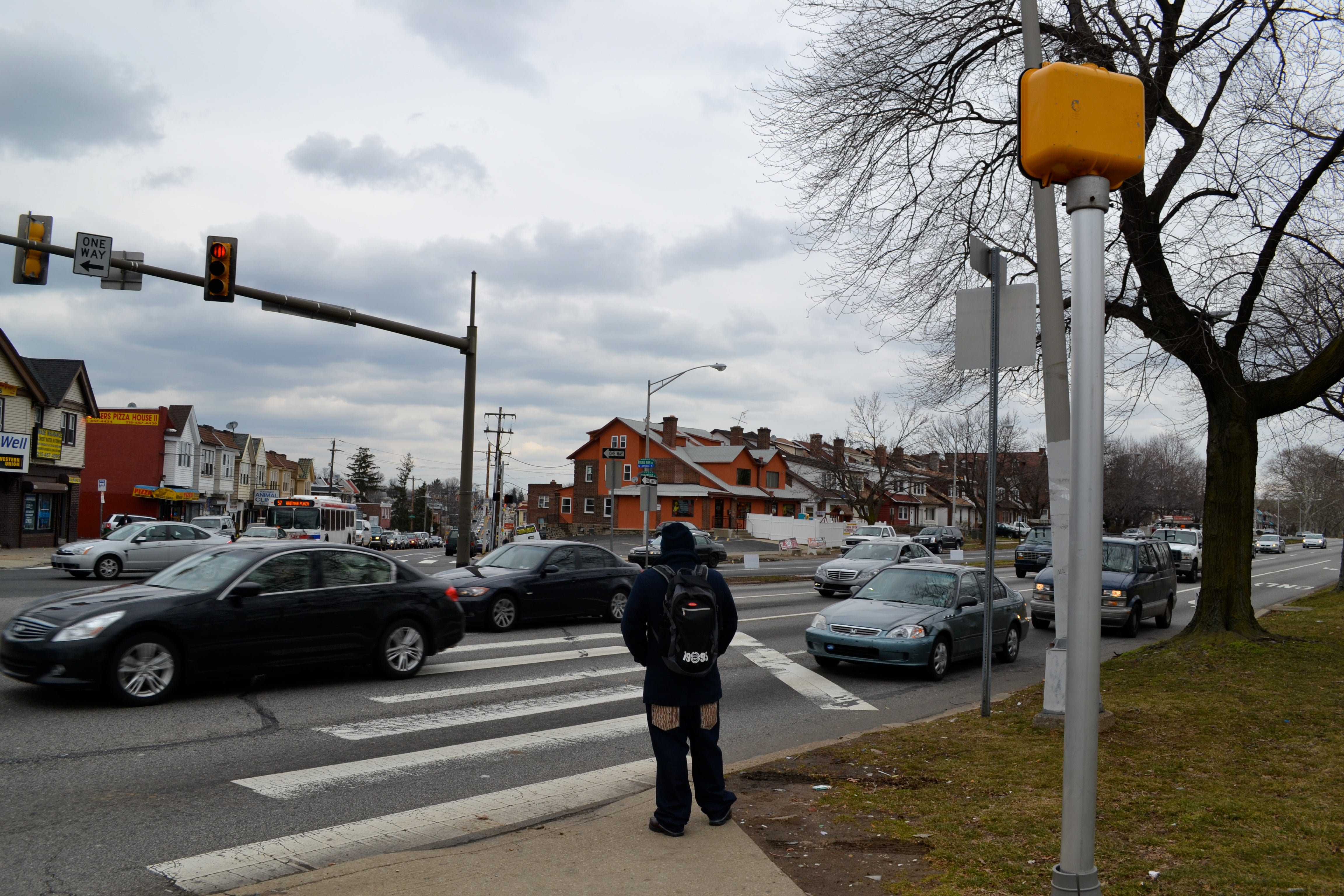Panel to consider Roosevelt Boulevard speed cameras

The wide, high-traffic boulevard poses a challenge to pedestrians (PlanPhilly Photo)
This week, Philadelphia will add two new automated red light enforcement (ARLE) cameras at the intersection of Ogontz and Stenton avenues.
Since 2005, Philadelphia has been using ARLE to ticket drivers who run red lights, and in the last fiscal year alone, the city issued more than 167,000 tickets. More importantly, supporters claim, it has improved driver behavior.
But state Sen. Michael Stack III (D., Phila.) wants to take photo traffic enforcement one step further and conduct a pilot using photo speed enforcement cameras on Roosevelt Boulevard in hopes of deterring excessive speeding and drag racing.
Stack began pushing for legislation to conduct a pilot last summer after a particularly horrific drag racing accident, and later this month, Stack will moderate a panel hosted by transportation advocacy group PenTrans to re-ignite the conversation around speed enforcement cameras on Roosevelt Boulevard.
Stack’s proposed legislation would allow the use of photo speed enforcement cameras on Roosevelt Boulevard from the Bucks County line to the interchange with I-76 and in work zones on the boulevard. The cameras would work much like Philadelphia’s red light cameras, but in this case, if a vehicle was being driven more than 10 miles per hour over the speed limit, a camera would snap a photo of the rear license plate. The Philadelphia police would affirm the violation, and a $100 ticket would be issued to the driver. As in the city’s ARLE program, any net profit would support a statewide fund for safety and mobility upgrades to Pennsylvania highways.
Supporters see the cameras as a way to improve safety.
“To me the chief benefit is saving lives,” said Jason Duckworth, PenTrans board director.
And safety issues, including excessive speeding and drag racing, have long plagued Roosevelt Boulevard.
“If it were built today it would never be designed the way it is,” said Jenny Robinson, Philadelphia public and government affairs for AAA Mid-Atlantic. “It was set up a long time ago, and we deal with it. It’s a very, very challenging highway in many respects.”
Previously, Stack has helped secure grant funding to support more police presence on the boulevard, helped install pedestrian crossing countdown timers and helped get pull offs built in the medians so that police have a place to safely pull vehicles over.
“While nothing can replace the jobs our police officers do … one thing we could do to complement the efforts of Philadelphia Police is put photo speed enforcement cameras on Roosevelt Boulevard,” said Stack’s Chief of Staff Matt Franchak.
Franchak said that after last summer’s gruesome drag racing accident, Stack asked Police Commissioner Charles Ramsey what else could be done on the boulevard. Ramsey, who helped introduce speed cameras to Washington D.C. during his time there, suggested using speed cameras on Roosevelt Boulevard.
Theoretically, Franchak said, if the pilot program were deemed successful on Roosevelt Boulevard, speed enforcement cameras could be used elsewhere in Philadelphia or, perhaps, Pennsylvania. For now though, the legislation will permit a pilot program on Roosevelt Boulevard specifically.
While there is no definite timeline, “Senator Stack is interested in trying to move this issue forward this year, hopefully getting some progress on the bill before June,” Franchak said.
Robinson, who will sit on the PenTrans hosted panel later this month, is wary though.
“We think it needs more time as far as clarifying the issues that we’re concerned with and making sure the right safeguards are there for motorists,” she said.
The bill does include safeguards such as only allowing photos of the rear license plate, disposing of photos within one year, requiring PennDOT approval of the cameras and installing signage to indicate speed cameras are in use. But Robinson lists other conditions that AAA would like to see – protections such as requiring traffic studies to determine camera placement, setting reasonable enforcement tolerances so that flagrant, rather than nominal infractions are targeted and issuing tickets within 10 days of the violation.
One obvious concern is privacy.
“The issue of using cameras is a sensitive one, and Senator Stack is certainly sensitive to that, but it’s kind of the world we live in right now,” Franchak said. “…That technology is here and businesses and the public are using it to improve public safety.”
Duckworth said the goal of this month’s panel is to bring these issues to light and to refocus public attention.
“Unfortunately government has a pattern of reacting to crisis, and we’re now nearly six months past that awful accident on the boulevard,” he said. “Other things have intervened. We get distracted by our lives and other issues, but there is real urgency to this.”
WHYY is your source for fact-based, in-depth journalism and information. As a nonprofit organization, we rely on financial support from readers like you. Please give today.
Panel to consider Roosevelt Boulevard speed cameras

This week, Philadelphia will add two new automated red light enforcement (ARLE) cameras at the intersection of Ogontz and Stenton avenues. Since 2005, Philadelphia has been using ARLE to ticket drivers who run red lights, and in the last fiscal year alone, the city issued more than 167,000 tickets. More importantly, supporters claim, it has improved driver behavior.
But state Sen. Michael Stack III (D., Phila.) wants to take photo traffic enforcement one step further and conduct a pilot using photo speed enforcement cameras on Roosevelt Boulevard in hopes of deterring excessive speeding and drag racing.
Stack began pushing for legislation to conduct a pilot last summer after a particularly horrific drag racing accident, and later this month, Stack will moderate a panel hosted by transportation advocacy group PenTrans to re-ignite the conversation around speed enforcement cameras on Roosevelt Boulevard.
Stack’s proposed legislation would allow the use of photo speed enforcement cameras on Roosevelt Boulevard from the Bucks County line to the interchange with I-76 and in work zones on the boulevard. The cameras would work much like Philadelphia’s red light cameras, but in this case, if a vehicle was being driven more than 10 miles per hour over the speed limit, a camera would snap a photo of the rear license plate. The Philadelphia police would affirm the violation, and a $100 ticket would be issued to the driver. As in the city’s ARLE program, any net profit would support a statewide fund for safety and mobility upgrades to Pennsylvania highways.
Supporters see the cameras as a way to improve safety.
“To me the chief benefit is saving lives,” said Jason Duckworth, PenTrans board director.
And safety issues, including excessive speeding and drag racing, have long plagued Roosevelt Boulevard.
“If it were built today it would never be designed the way it is,” said Jenny Robinson, Philadelphia public and government affairs for AAA Mid-Atlantic. “It was set up a long time ago, and we deal with it. It’s a very, very challenging highway in many respects.”
Previously, Stack has helped secure grant funding to support more police presence on the boulevard, helped install pedestrian crossing countdown timers and helped get pull offs built in the medians so that police have a place to safely pull vehicles over.
“While nothing can replace the jobs our police officers do … one thing we could do to complement the efforts of Philadelphia Police is put photo speed enforcement cameras on Roosevelt Boulevard,” said Stack’s Chief of Staff Matt Franchak.
Franchak said that after last summer’s gruesome drag racing accident, Stack asked Police Commissioner Charles Ramsey what else could be done on the boulevard. Ramsey, who helped introduce speed cameras to Washington D.C. during his time there, suggested using speed cameras on Roosevelt Boulevard.
Theoretically, Franchak said, if the pilot program were deemed successful on Roosevelt Boulevard, speed enforcement cameras could be used elsewhere in Philadelphia or, perhaps, Pennsylvania. For now though, the legislation will permit a pilot program on Roosevelt Boulevard specifically.
While there is no definite timeline, “Senator Stack is interested in trying to move this issue forward this year, hopefully getting some progress on the bill before June,” Franchak said.
Robinson, who will sit on the PenTrans hosted panel later this month, is wary though.
“We think it needs more time as far as clarifying the issues that we’re concerned with and making sure the right safeguards are there for motorists,” she said.
The bill does include safeguards such as only allowing photos of the rear license plate, disposing of photos within one year, requiring PennDOT approval of the cameras and installing signage to indicate speed cameras are in use. But Robinson lists other conditions that AAA would like to see – protections such as requiring traffic studies to determine camera placement, setting reasonable enforcement tolerances so that flagrant, rather than nominal infractions are targeted and issuing tickets within 10 days of the violation.
One obvious concern is privacy.
“The issue of using cameras is a sensitive one, and Senator Stack is certainly sensitive to that, but it’s kind of the world we live in right now,” Franchak said. “…That technology is here and businesses and the public are using it to improve public safety.”
Duckworth said the goal of this month’s panel is to bring these issues to light and to refocus public attention.
“Unfortunately government has a pattern of reacting to crisis, and we’re now nearly six months past that awful accident on the boulevard,” he said. “Other things have intervened. We get distracted by our lives and other issues, but there is real urgency to this.”
WHYY is your source for fact-based, in-depth journalism and information. As a nonprofit organization, we rely on financial support from readers like you. Please give today.



